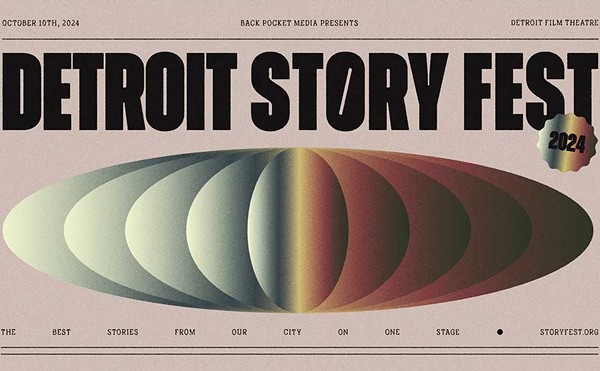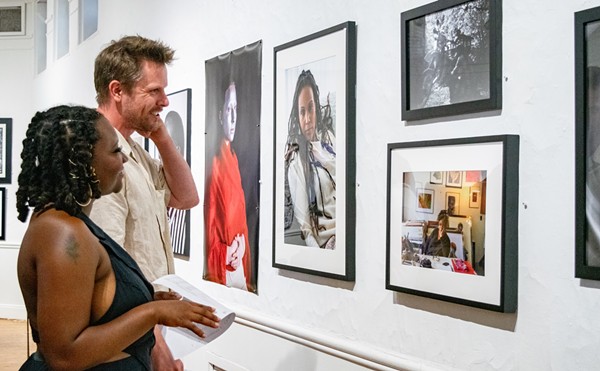Aureliano Hernandez isn’t distracted by the sounds of scraping metal chairs and noisy chatter in his high school classroom. The bespectacled teenager is talking about his life, and he’s trying to convey something personal and sensitive. He speaks thoughtfully, carefully contemplating his answers and sprinkling in small jokes that don’t always quite come off.
Hernandez was born in Mexico. He’s 18 and a senior at Southwest Detroit’s Chadsey High School. His father is a construction worker. His mother stays at home, and Hernandez has four siblings. This fall, he plans to go to the University of Detroit Mercy to study civil engineering.
Hernandez explains that despite his ambition and 3.7 grade point average, he feels that when strangers see him, they assume he’s a troublemaker, if they notice him at all. He can almost hear them thinking, “just another bad Detroit kid.”
“They probably think that, ‘Oh, here goes this kid, he’s probably up to something. Why’s he walking with his friends?’” says Hernandez. “When people see a lot of people together, they always think they’re going to do something wrong.”
If you saw Hernandez walking down the street with his slicked-back hair, what would you think? Would you notice him at all?
Cut to Hernandez’s portrait, which debuts this weekend at the Detroit Institute of Arts. The photograph overwhelms, its 50-inch-by-40-inch size forces you to examine Hernandez’s plain T-shirt and thick forearms. His eyes seem to bore into you. He looks sure of his intelligence.
But it’s the eyes that suck you in. What is he thinking?
Hernandez says he hopes his portrait will show people he’s more than just a Detroit high school kid.
“I want them to think I have something to look forward [to] in life,” he says.
Photographer Dawoud Bey wants people to think that too.
This Sunday, Bey’s portraits of 18 Chadsey students, taken over five weeks last fall, go on display at the DIA. The students’ own art and written pieces, and a video featuring four students telling their stories, also will be displayed.
Bey has done similar portrait projects at schools from Chicago to London. But he says that Chadsey, a school of more than 850 students, is the most culturally diverse he’s ever photographed.
The students are black, white, Latino, Romanian, Iraqi. Many of them are poor. Fewer than half of those who start at the school as freshmen graduate. A number of female students every year have babies. Other students are emancipated from their parents or live in youth homes.
Teens at the school face daunting challenges, says Chadsey art teacher Eileen Finnegan.
“They’ve been beaten down so much that they don’t have the confidence in themselves,” Finnegan says. “Oftentimes, either at home or at school, nobody sees the greatness and the intellectual capacity.”
What people will think when they see Bey’s portraits at Detroit’s premier art and cultural institution is up to them. Bey bets museum visitors will be affected somehow.
“The pictures [are] about looking. You look and you look more intensely and more deeply and you begin to see things,” Bey says. “Not just a kid from Chadsey, but that you have confronted and engaged with another human being — someone whose experience, through pictures and text, you can now relate to,” he says.
Finnegan says the students will be surprised by their own reactions to the exhibit.
“It will be a turning point in their lives to have been included in this. It may be one of the things that they take away from their education and remember as a highlight,” she says.
Bey gives voice
For most of his nearly 30-year career, Chicago photographer Bey has tried to give the viewer pause to contemplate the people in his photos, to imagine something about them.
In recent years, Bey has focused on portraits of teenagers, mainly from poor, urban high schools. He says his work is a way to bring a social aspect into the aesthetic realm and to give voice to those who don’t usually have one.
Because his work often exhibits in major art museums and cultural institutions, his exhibits bring two segments of society together that don’t often meet: low-income inner-city kids and upper-income, highly educated art consumers. Bey says he taps the communities surrounding museums for subject matter.
As Bey puts it, “That sets up a much more interesting and dynamic set of relationships between the community and the institution, to bring the outside, the community, inside of the museum.”
He chooses “the schools of the people who get lost in the shuffle,” adding, “That’s what Chadsey is.”
It’s hard to put a finger on what makes Bey’s photographs compelling. An art critic could go on about the lighting and contrasts, but in the end, it’s about the people, especially the way they look at you.
“It’s not like typical photography,” says Nancy Barr, curator of the DIA exhibition. People “have an emotional response to the pictures,” she says.
In the portraits, the students sit, though their poses vary. Some have their heads on their arms; others pose upright. The background is just some room, out-of-focus and unimportant.
What’s arresting is the kids, their intense stares, their postures, their clothing. The symmetry of their bodies and the curves of their shoulders, heads and elbows require contemplation.
It’s also their words.
A few paragraphs written by the students accompany the photographs. Bey takes the pictures first, knowing little about each student. The words come later. The portrait might not directly correspond to what the subjects write, and the two elements combined add further depth to the works.
“When I want to get away I can’t. I can never get away because there’s always this annoying crying voice every time I leave out the room,” writes Chadsey student Shaheeda for Bey’s DIA series. “I wish I could fly. If I could fly, I would fly to school and never be late. I would fly in the sky with the birds.”
The words reflect the desperate feeling of a mother, the immaturity of a teenager and a glimpse of the poetic. The portrait shows a young black girl, sitting on the floor with her legs drawn up close to her chest, the angles sharp, her eyes sad.
Sukana writes about her Muslim faith and the conflict between her belief and her behavior. In her photo she looks sophisticated, a girl concerned about her appearance down to the smallest details.
David Puia writes about what his life will be like when he’s 25.
“I’ll be spending time with my wife, tuning cars, messing with electronics,” he writes.
“I never had an experience like this,” Puia says in an interview about the project. “I’m a little shocked because I’ve never been exposed, you know.”
Puia’s text accompanies a portrait of a tired young man, the slight curve of bags under his eyes, an image that raises more questions than it answers the longer one considers it.
Puia’s family came from Romania in 1996. His parents don’t speak English. The oldest of nine children, the 15-year-old sophomore is big brother, babysitter and translator.
When people see the portraits, Puia wants them to leave with a good impression.
“When they come over here they see the pictures, they read the stuff that we wrote down. They’re going to change their ideas,” he says. “You know people, what they say about Detroit, ‘It’s not that good.’”
Once people see the pictures, he says, “They’re going to probably think ‘It’s not that bad.’”
Portrait of an artist
Bey aims to take photographs that describe in some “compelling, emotional, logical or physical aspect, who we are as human beings,” he says.
The celebrated photographer grew up in Queens, N.Y., in what he describes as a black working-class household, complete with a yard and a dog. Starting in third grade, he was bused to a school that was nearly all-white, part of desegregation efforts in the 1960s.
He says for many years, he was one of two or three black kids in the class. When items would disappear from the classroom, or if his homework looked too well done, he was sent to the guidance counselor.
“I spent a lot of time in elementary school feeling like I was in the twilight zone. I couldn’t figure out what was going on,” he says.
By the time he got to high school, he says he wasn’t that interested in school anymore.
“I don’t remember anyone asking me what was on my mind, what I was thinking about,” he says.
His interest in photography began in 1969, when he was about 16 years old, with a visit to the Metropolitan Museum of Art and the gift of a camera from his godmother.
With no formal training, he set out to make pictures in 1975. His first exhibition, Harlem, USA, showed in 1979 at the Studio Museum of Harlem. He received a master’s degree from the Yale University School of Art in 1993. He’s now a photography professor at Columbia College in Chicago.
As a teacher, he tells his students to first examine their own interests, then go out and take pictures reflective of them.
“You’re better off thinking for a little bit: What are you committed to?” he says.
His choice of portraits, he says, comes from a curiosity about people “and my own belief that I can describe something meaningful about the human subject by making photographs.”
Jessica Baker, 17, thinks Bey’s portrait of her reflects her personality, and she believes others will see that when they view the exhibit.
“I want them to come away with just some interesting information about me,” Baker says. “I mean, I don’t have to be famous or anything, but maybe it’ll do something to their lives.”
The photo shows a girl with little to hide. She can barely suppress her smile, her eyes full of glee as she sits upright.
Next to her picture, her essay begins, “I had cancer when I was five. … My biggest challenge was when I went through the radiation and chemotherapy. I was very strong.”
She ends it with: “I want people to remember me as a very good, kind, cheerful person.”
Dawoud Bey: Detroit Portraits will be on view at the DIA from April 4 to Aug. 1. The DIA is located at 5200 Woodward Ave. Call 313-833-7899 or visit www.dia.org.





